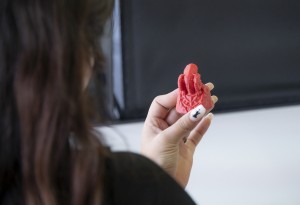Press notes 09/08/2023
The digitisation of historical objects is transforming the study, preservation and dissemination of cultural heritage
The URV has started to use digital twins in the degrees in History and the History of Art and Archaeology, and also in research. The use of these technologies raises new debates and the need for critical reflection from a humanist perspective

The URV has started to use digital twins in the degrees in History and the History of Art and Archaeology, and also in research. The use of these technologies raises new debates and the need for critical reflection from a humanist perspective
The Universitat Rovira i Virgili is leading a change in the world of research and teaching by digitising cultural heritage in the Humanities. Digital twins are pieces of art or cultural heritage that are re-created digitally so that they can be studied, disseminated and preserved.
This technology is transforming fields of study such as History, Art History and Archaeology. For this reason, URV degrees are already offering students the chance to develop these skills and open up new professional opportunities. They are now working with this 3D digitisation in a variety of methodologies.
Bringing technology closer to education
According to Ignacio Fiz and Vanina Hofman, professors at the URV’s Department of History and Art History, photogrammetry is one of the techniques that can be used to create 3D models from photographs. This procedure has been used to digitise such features of heritage as archaeological sites and monuments. Students can capture the images themselves with their own cameras and the URV provides them with the software they need to transform the images into a 3D re-creation.
In addition to photogrammetry, the URV has been acquiring other technologies, such as small laser scanners and virtual reality glasses, and also collaborates with the Giravolt project, an initiative of the Government of Catalonia to digitise Catalan cultural heritage and which makes high-end laser scanner technology available to institutions such as the National Museum of Archaeology of Tarragona (MNAT), with whom the URV often collaborates. This collaboration has made it possible to carry out projects such as the 3D digitisation of the early Christian necropolis.
According to Ignacio Fiz, the teaching of the humanities has benefitted from using these technologies, as students are trained for a job market in which they will have to work alongside digitisation. In this respect, there are two types of worker: on the one hand, graduates who join projects that already use these methodologies so they need technical knowledge to understand other professionals; and, on the other, graduates who are specifically trained as technicians. This is why in the academic year 2019-20 the URV’s degrees in History, History of Art and Archaeology started to use digital humanities as a research methodology to prepare students for professional opportunities in interdisciplinary teams.
The aim of this experiential learning “is for students to enter into dialogue and collaboration with other professional profiles”, as “it is crucial that students be prepared to understand each other and work together with much more technical profiles.” They should also be given the chance to specialise in them if they wish, says Fiz.
One example is the graduate Maria Mercè Grau, who, as part of her final degree project, replicated 15 pieces in collaboration with the National Archaeological Museum of Tarragona (MNAT). In addition to systematising and developing the process, her research analyses how they can be conserved, restored and disseminated by creating models for video games, 3D printing, architectural documentation, etc.
Other researchers such as Eva Subias, from the URV’s Department of History and Art History has been working with digital technologies at the Puig Rom site in Roses, Girona, where she uses drones for photogrammetry. These tools make it possible to document each work campaign and generate digital models that can be used to study, disseminate and preserve the heritage.
Rethinking technology from a humanist perspective: new uses
Vanina Hofman, professor and researcher at the Department of History and History of Art, also points out how cooperation between entities and job types not only ensures that technology and knowledge is shared but also helps to enrich debate and analysis. For this reason, she insists that it is necessary to continue promoting synergies between entities that favour this exchange of knowledge and experiences in the digitisation of cultural heritage. Along these lines, last April they organised a joint activity with the MNAT and Giravolt, and with the participation of the URV’s Learning and Research Centre, to raise awareness of these techniques for the digitisation of cultural heritage among new audiences. The URV also works in collaboration with the Catalan Institute of Classical Archaeology (ICAC).
Hofman assures that all these activities are putting technology to new uses that until recently had gone unnoticed in the humanities and which “not only extend the possibilities in the study and preservation of works of art but also lead to new narratives that help to explain heritage.”
She insists that all these issues are generating new discussions in the humanities and calls for a more critical view of technology. She points out that, as well as issues of the storage, cataloguing and accessibility of the information generated, the use of these technologies raises new debates about digital culture and the boundaries between the physical and virtual worlds: “it is necessary to explore the relationship between the original work and its digital recreation, the identity of all the documentation that is generated during the process of creating a new digital object or the ownership and management of the rights that derive from each work,” she says.





